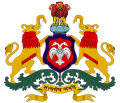| Mysore State | |||||||||
|---|---|---|---|---|---|---|---|---|---|
| State of India | |||||||||
| 1947–1973 | |||||||||
 Mysore State, 1951 | |||||||||
 Mysore state, 1956 | |||||||||
| Capital | Bangalore | ||||||||
| Government | |||||||||
| Rajpramukh | |||||||||
• 1950–1956 | Jayachamarajendra Wadiyar | ||||||||
| History | |||||||||
| 9 August 1947 | |||||||||
• Renamed Karnataka State | 1 November 1973 | ||||||||
| |||||||||
| Today part of | India | ||||||||
Mysore State, colloquially Old Mysore, was a political territory within the Dominion of India and the subsequent Republic of India from 1947 until 1956. The state was formed by renaming the Kingdom of Mysore, and Bangalore replaced Mysore as the state's capital when Parliament passed the States Reorganisation Act in 1956. [1] Mysore State was considerably enlarged when it became a linguistically homogeneous Kannada-speaking state within the Republic of India by incorporating territories from Andhra, Bombay, Coorg, Hyderabad, and Madras States, as well as other petty fiefdoms. It was subsequently renamed Karnataka in 1973. [2]














